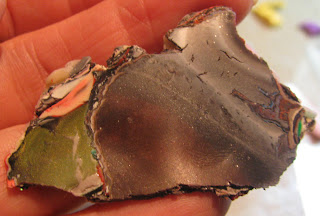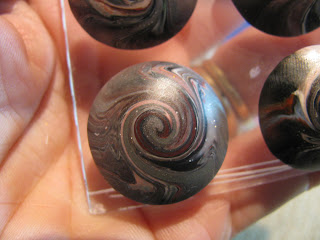
(click on pictures for larger images)
I start with a pile of scrap, thick pieces rolled fairly flat, canes sliced open and rolled flat. Grab individual pieces and stack them on top of each other randomly.
Roll this stack flat, tear in half, stack, tear in half again, stack, roll out again. Look at the edges you retain when you tear the clay rather than folding and rolling or cutting and rolling.

The beauty of polymer clay is that it retains the original colours even though stacked and rolled several times, just as it does when you make a cane that you repeatedly reduce.
As the sheet becomes more homogeneous and greys out, these edges pull brilliant colour and strong contrast back into the sheet, and that's what I use to make the spiral lentil beads. I now tear the sheet into bead-sized pieces, making sure I get some of these edges and embedded edges into each piece, then it's time to fold the sheet into undulating folds, keeping as much of the edges visible as you want.



This bead has some interesting edges showing, but there is a fairly large, bland part, and that won't translate into a spiral pattern, so you can cut int the bead in the boring area and the undulations will reveal more edges interestingly patterned.

The result is a related batch of interesting beads, even though the overall blends are grey. The interest comes primarily from the colours and contrast found at the edges. These are raw, so I'll bake them tomorrow and sand and buff and show the final beads. You can imagine how interesting your beads would be if you were selective in using scrap that included metal leaf, glitter, metallic clays, etc.
















My left brain loves your detailed instructions, Vickie. My right brain grooves on the awesome result of said instructions. This is definitely a must-try for me... thanks for sharing it!
ReplyDeleteHi Monique, thanks for stopping by and especially for leaving your comment. I've just finished sanding and buffing the beads and can't wait to show the finished results. I'm starting to realize that this blog is sort of my lab notes, lol! My left brain refuses to let my right brain have all the fun!
Delete